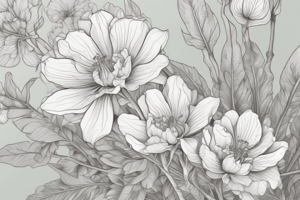Podcast
Questions and Answers
What is the term for a flower that has both androecium and gynoecium?
What is the term for a flower that has both androecium and gynoecium?
- Bisexual (correct)
- Pedicellate
- Sessile
- Unisexual
What is the function of the calyx and corolla in a flower?
What is the function of the calyx and corolla in a flower?
- They are responsible for reproduction
- They are responsible for protection of inner whorls (correct)
- They are responsible for the development of the embryo sac
- They are responsible for the production of pollen
What is the term for a flower that has only one of the essential whorls?
What is the term for a flower that has only one of the essential whorls?
- Pedicellate
- Unisexual (correct)
- Bisexual
- Sessile
What is the function of the stigma in a flower?
What is the function of the stigma in a flower?
What is the term for the process of pollen grains being transferred to the stigma?
What is the term for the process of pollen grains being transferred to the stigma?
What is the function of the ovary in a flower?
What is the function of the ovary in a flower?
What is the term for a flower that has a stalk?
What is the term for a flower that has a stalk?
What is the function of the pollen tube?
What is the function of the pollen tube?
Flashcards are hidden until you start studying
Study Notes
Structure of a Flower
- A flower consists of four floral whorls: calyx, corolla, androecium, and gynaecium, arranged in sequence from outside to inside.
- Androecium and gynaecium are called 'essential whorls' because they perform the function of reproduction.
- Calyx and corolla are called 'accessory whorls' because they are responsible for protecting the inner whorls.
Components of a Flower
- Members of calyx are called 'sepals' and are green in color.
- Members of corolla are called 'petals' and are variously colored.
- Androecium is the male whorl and its members are called 'stamens'.
- Gynaecium is the female whorl and its members are called 'carpels'.
Types of Flowers
- A flower is called 'bisexual' if both androecium and gynaecium are present in the same flower.
- A flower is called 'unisexual' if only one of the essential whorls is present in the flower.
- A unisexual flower with only androecium is called a 'male flower', and a unisexual flower with only gynaecium is called a 'female flower'.
Support and Attachment
- Many flowers have a stalk for support, called a 'pedicel', and are called 'pedicellate'.
- Flowers without a stalk are called 'sessile'.
Reproductive Process
- Ovary is present at the basal end of each carpel, and contains one or many ovules.
- Each ovule contains an embryo sac formed by meiosis, consisting of a haploid egg cell and two haploid polar nuclei.
- Pollination occurs when pollen grains from an anther are transferred to the stigma, either through abiotic or biotic agents.
- Pollen germinates on the sticky stigma, forming a pollen tube that carries male gametes to the embryo sac.
- Fertilization occurs when a male gamete unites with the egg cell to form a zygote.
- Double fertilization occurs when the second male gamete unites with the two polar nuclei to form endosperm.
Studying That Suits You
Use AI to generate personalized quizzes and flashcards to suit your learning preferences.




